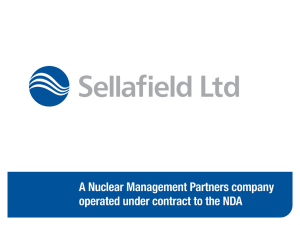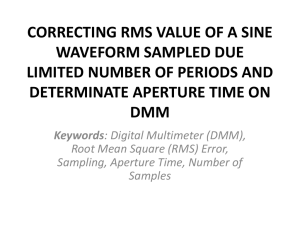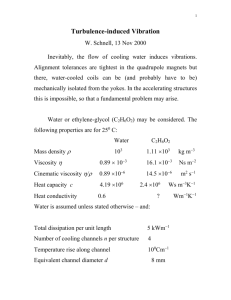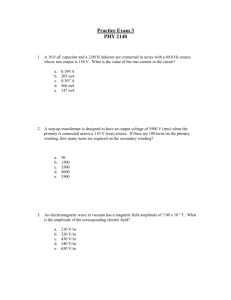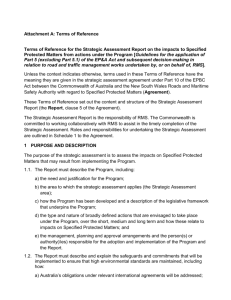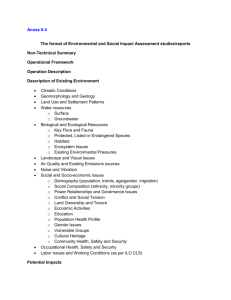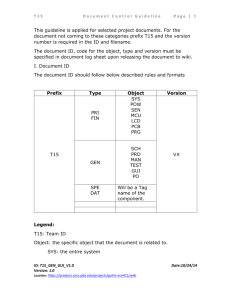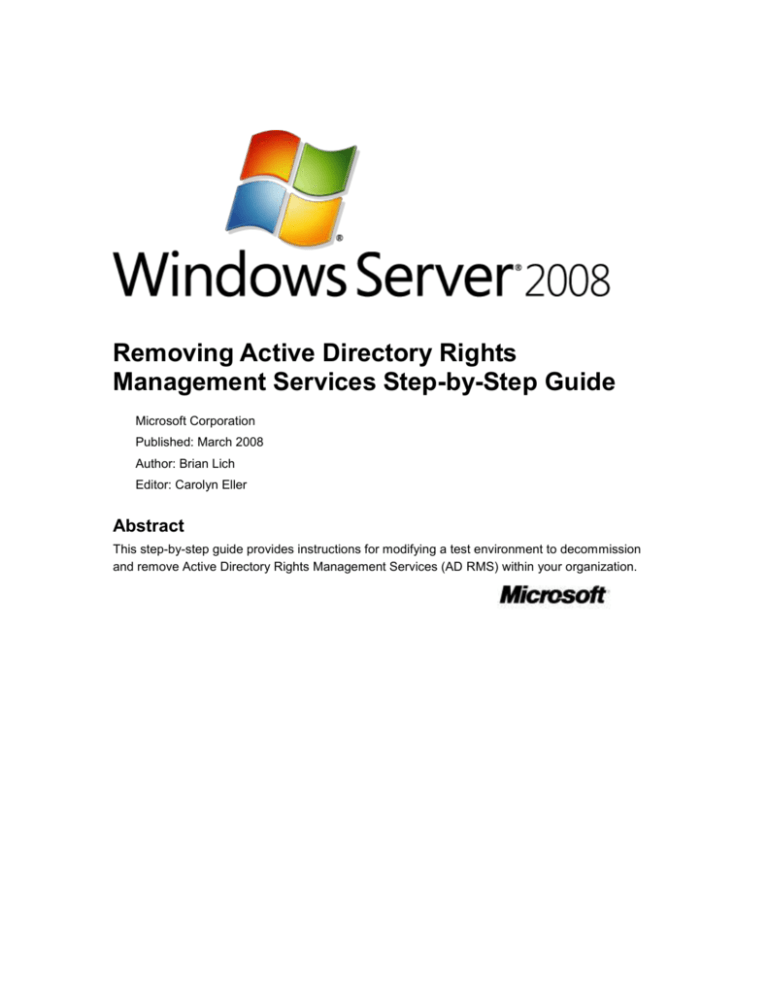
Removing Active Directory Rights
Management Services Step-by-Step Guide
Microsoft Corporation
Published: March 2008
Author: Brian Lich
Editor: Carolyn Eller
Abstract
This step-by-step guide provides instructions for modifying a test environment to decommission
and remove Active Directory Rights Management Services (AD RMS) within your organization.
This document is provided for informational purposes only and Microsoft makes no warranties,
either express or implied, in this document. Information in this document, including URL and other
Internet Web site references, is subject to change without notice. The entire risk of the use or the
results from the use of this document remains with the user. Unless otherwise noted, the example
companies, organizations, products, domain names, e-mail addresses, logos, people, places, and
events depicted herein are fictitious, and no association with any real company, organization,
product, domain name, e-mail address, logo, person, place, or event is intended or should be
inferred. Complying with all applicable copyright laws is the responsibility of the user. Without
limiting the rights under copyright, no part of this document may be reproduced, stored in or
introduced into a retrieval system, or transmitted in any form or by any means (electronic,
mechanical, photocopying, recording, or otherwise), or for any purpose, without the express
written permission of Microsoft Corporation.
Microsoft may have patents, patent applications, trademarks, copyrights, or other intellectual
property rights covering subject matter in this document. Except as expressly provided in any
written license agreement from Microsoft, the furnishing of this document does not give you any
license to these patents, trademarks, copyrights, or other intellectual property.
© 2008 Microsoft Corporation. All rights reserved.
Microsoft, Active Directory, MS-DOS, Windows, Windows NT, and Windows Server are either
registered trademarks or trademarks of Microsoft Corporation in the United States and/or other
countries.
All other trademarks are property of their respective owners.
Contents
Decommissioning Active Directory Rights Management Services Step-by-Step Guide ................. 5
About This Guide.......................................................................................................................... 5
What This Guide Does Not Provide .......................................................................................... 5
Deploying AD RMS in a Test Environment .................................................................................. 5
Step 1: Decommission AD RMS Root Cluster ................................................................................ 7
Enable the decommissioning service ........................................................................................... 7
Set permission on the decommissioning pipeline ........................................................................ 8
Configure the AD RMS-enabled application to use the decommissioning pipeline ..................... 9
Step 2: Verifying AD RMS Functionality .......................................................................................... 9
Decommissioning Active Directory Rights
Management Services Step-by-Step Guide
About This Guide
This step-by-step walks you through the process of decommissioning Active Directory Rights
Management Services (AD RMS) in your organization. Removing AD RMS requires that all rightsprotected content that you want to be able to use be decrypted before all servers are removed
from the AD RMS cluster.
Once complete, you can use the test lab environment to learn about AD RMS decommissioning
on Windows Server® 2008 and assess how it might be deployed in your organization.
As you complete the steps in this guide, you will:
Decommission an AD RMS cluster.
Verify the removal of AD RMS functionality after you complete the configuration.
This guide assumes that you previously completed the steps in the Windows Server Active
Directory Rights Management Services Step-by-Step Guide
(http://go.microsoft.com/fwlink/?LinkId=72134), and that you have already deployed the following
components:
An AD RMS server
An AD RMS database server
One AD RMS-enabled client
One Active Directory domain controller
What This Guide Does Not Provide
This guide does not provide the following:
An overview of AD RMS. For more information about the advantages that AD RMS can bring
to your organization, see http://go.microsoft.com/fwlink/?LinkId=84726.
Guidance for setting up and configuring AD RMS in a production environment.
Complete technical reference for AD RMS.
Deploying AD RMS in a Test Environment
We recommend that you first use the steps provided in this guide in a test lab environment. Stepby-step guides are not necessarily meant to be used to deploy Windows Server features without
additional deployment documentation and should be used with discretion as a stand-alone
document.
5
Upon completion of this step-by-step guide, you will have a decommissioned AD RMS
infrastructure. You can then test and verify AD RMS functionality by opening a rights-protected
document and ensuring that the document is decrypted.
The test environment described in this guide includes four computers connected to a private
network and using the following operating systems, applications, and services:
Computer Name
Operating System
Applications and Services
ADRMS-SRV
Windows Server 2008
AD RMS, Internet Information
Services (IIS) 7.0, World Wide
Web Publishing Service, and
Message Queuing
CPANDL-DC
Windows Server 2008 or
Windows Server 2003 with
Service Pack 2 (SP2)
Active Directory or Active
Directory Domain Services
(AD DS), Domain Name System
(DNS)
Note
Service Pack 2 for
Windows Server 2003 is
not required but will be
used for the purposes of
this guide.
ADRMS-DB
Windows Server 2003 with SP2
Note
Service Pack 2 for
Windows Server 2003 is
not required but will be
used for the purposes of
this guide.
ADRMS-CLNT
Windows Vista®
Microsoft SQL Server® 2005
Standard Edition with Service
Pack 2 (SP2)
Note
Service Pack 2 for SQL
Server 2005 Standard
Edition is not required
but will be used for the
purposes of this guide.
Microsoft Office Word 2007
Enterprise Edition
Note
For more information about the system requirements for installing AD RMS, see
http://go.microsoft.com/fwlink/?LinkId=84733.
The computers form a private intranet and are connected through a common hub or Layer 2
switch. This configuration can be emulated in a virtual server environment if desired. This stepby-step exercise uses private addresses throughout the test lab configuration. The private
network ID 10.0.0.0/24 is used for the intranet. The domain controller is named CPANDL-DC for
6
the domain named cpandl.com. The following figure shows the configuration of the test
environment:
Step 1: Decommission AD RMS Root Cluster
Decommissioning refers to the entire process of removing the AD RMS cluster and its associated
databases from an organization. This process allows you to save rights-protected files as ordinary
files before you remove AD RMS from your infrastructure so that you do not lose access to these
files.
Decommissioning an AD RMS cluster is achieved by doing the following:
Enable the decommissioning service.
Modify permissions on the decommissioning pipeline.
Configure the AD RMS-enabled application to use the decommissioning pipeline.
Enable the decommissioning service
The decommissioning service disables all other AD RMS services in the cluster. When the
decommissioning service is enabled, AD RMS clients can request only a key to decrypt rightsprotected content. The decommissioning service is enabled by using the Active Directory Rights
Management Services console.
To enable the decommissioning service
1. Log on to ADRMS-SRV as cpandl\adrmsadmin.
2. Click Start, point to Administrative Tools, and then click Active Directory Rights
Management Services.
3. If the User Account Control dialog box appears, confirm that the action it displays is
what you want, and then click Continue.
4. Expand the AD RMS cluster, expand Security Policies, and then click
7
Decommissioning.
5. In the Actions pane, click Enable Decommissioning.
6. Click Decommission.
Caution
Once decommissioning has been enabled on the AD RMS cluster, it cannot be
reversed.
7. Click Yes, confirming that you want to decommission the AD RMS cluster.
Set permission on the decommissioning pipeline
After the decommissioning service is enabled on the AD RMS cluster, you must modify the
permissions on the decommissioning pipeline so that AD RMS users can connect to it. By default,
only the local SYSTEM account has access to the pipeline. You should give the AD RMS Service
Group the Read & execute permission on the decommission folder. Then on the
decommission.asmx file, you should give everyone the Read & execute permission. The
decommission pipeline is located in the %systemroot%\inetpub\wwwroot\_wmcs folder, where
%systemroot% is the volume on which Windows Server 2008 is installed.
To modify the permissions on the decommissioning pipeline
1. Log on to ADRMS-SRV as cpandl\administrator.
2. Click Start, type %systemdrive%\inetpub\wwwroot\_wmcs in the Start Search box,
and then press ENTER.
3. Right-click the decommission folder, and then click Properties.
4. Click the Security tab, click Edit, and then click Add.
5. In the Select Users, Computers, or Groups box, type ADRMS-SRV\AD RMS Service
Group, and then click OK.
6. Click OK twice to close the decommission properties.
7. Double-click the decommission folder, right-click decommission.asmx, and then click
Properties.
8. Click the Security tab, click Edit, and the click Add.
9. In the Select Users, Computers, or Groups box, type Everyone, and then click OK. In
the Windows Security dialog box, enter the name and password of the
cpandl\administrator account.
10. Click OK twice to close the properties sheet.
Caution
When the AD RMS cluster is operating in decommissioning mode, all users, whether or
not they had rights to the original rights-protected content, can obtain a content key and
gain full rights to the content.
8
Configure the AD RMS-enabled application to use
the decommissioning pipeline
Once the AD RMS cluster is in decommissioning mode, you must configure the AD RMS-enabled
applications to obtain a content key from the decommissioning service and permanently decrypt
the rights-protected content. The AD RMS client itself has no part in the decommissioning
process.
To configure the AD RMS-enabled application to use the decommissioning pipeline
1. Log on to ADRMS-CLNT as cpandl\nhollida.
2. Click Start, type regedit in the Start Search box, and then press ENTER.
Caution
Incorrectly editing the registry may severely damage your system. Before making
changes to the registry, you should back up any valued data on the computer.
3. Navigate to HKEY_CURRENT_USER\Software\Microsoft\Office\12.0\Common\DRM.
4. Right-click DRM, point to New, and then click Key.
5. Type Decommission as the name for the registry key, and then press ENTER.
6. Right-click Decommission, point to New, and then click String Value.
7. Type https://adrms-srv.cpandl.com/_wmcs/licensing, and then press ENTER.
8. Double-click the registry entry.
9. In the Value data box, type https://adrms-srv.cpandl.com/_wmcs/decommission, and
then click OK.
10. Close Registry Editor.
11. Repeat steps 1-10 for Stuart Railson and Limor Henig.
Step 2: Verifying AD RMS Functionality
Once the content is decrypted, the user should then save the content without AD RMS protection.
To use the decommissioning service, the user must have been previously enrolled within the
AD RMS infrastructure. A user without an activated AD RMS client cannot use the
decommissioning service to gain access to rights-protected content.
If the decommissioning service is working correctly, any user in the domain, using a computer
with the AD RMS-enabled application configured to use the decommissioning service, can open
any file that was rights-protected by the AD RMS cluster being decommissioned, remove the
rights protection, and save the file. To verify this, you log on as Limor Henig, open the ADRMSTST.docx file that was created with rights protection in the Windows Server Active Directory
Rights Management Services Step-by-Step Guide, remove the rights protection, and save the file.
9
To save a document without rights protection
1. Log on to ADRMS-CLNT as Limor Henig (cpandl\lhenig).
2. Click Start, point to All Programs, point to Microsoft Office, and then click Microsoft
Office Word 2007.
3. Click the Microsoft Office Button, click Open, and then type \\ADRMS-DB\PUBLIC
\ADRMS-TST.docx.
4. When the document opens, click the Change Permissions button and clear the Restrict
permissions to this document check box, and then click OK.
5. Save the file as you normally would anything other document.
You have successfully enabled the AD RMS decommissioning service, removed rights-protection
from a document, and then saved it without rights-protection. Once you have ensured that all
rights-protected content is decrypted and saved without rights-protection, you can unregister the
SCP by using the Active Directory Rights Management Services console, uninstall AD RMS, and
reprovision these servers for other services.
10


